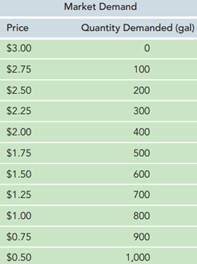Reference no: EM131830762
The French economist Antoine Cournot developed an interesting model of competition in an oligopoly that now bears his name.
In a Cournot oligopoly, all of the firms know that the total output from all firms will determine the price (based on the downward-sloping market demand curve), but they make independent and simultaneous decisions about how much output to produce. Cournot developed this model after observing how a spring water duopoly (two firms) behaved.
So let's look at a duopoly example. For each firm to decide how much to produce, it must make a guess about how much the other firm is going to produce.
Also, the firms basically assume that once the other firm has decided how much to produce, it can't really change its decision. Here's an example. Suppose the market demand curve for gallons of fresh spring water looks like the one in the next table and, to keep things simple, the marginal cost of spring water is zero.
If Firm X believes that Firm Y is going to produce 100 gallons of spring water, for example, then Firm X knows that if it produces 0 gallons, the price will be $2.75; if it produces 100 gallons, the price will be $2.50, and so on. Basically, Firm X will face its own demand curve where all of the quantities are lower by 100.

Based on this demand schedule, calculate the demand schedule that Firm X would face if it suspected Firm Y was going to produce 0, 200, 400, or 600 gallons of spring water. Then, figure out the profit-maximizing amount of spring water for Firm X to produce in response. Fill in the table.

What you have just constructed is what economists would call Firm X's reaction function. Even though Firm X thought about the different choices Firm Y could make, Firm Y is not actually going to choose just any random level of output.
In fact, Firm Y has its own reaction function, where it considers how best to respond to what it thinks Firm X is doing. Because both firms have the same zero marginal cost, the two reaction functions are symmetrical.
(Thus, Firm Y's reaction function looks the same, only with "X" and "Y" switched.) Graph the two reaction functions. Do you notice any points that stand out? Describe why this point represents an equilibrium for both firms.
|
Design a spreadsheet to keep track of your expenses
: Assume you are going on a business trip. Design a spreadsheet to keep track of your expenses and create a summary of your totals.
|
|
Design a spreadsheet to maintain a grade sheet
: Design a spreadsheet to maintain a grade sheet for a set of students. Include tests and projects, given various weights to each in calculation of final grade.
|
|
Prepare the entry to record the mortgage loan
: Jenseng Inc. issues a $800,000, 10%, 10-year mortgage note on December 31, 2017, to obtain financing for a new building.
|
|
Review MS Visio functions
: ACC 351: Accounting Information Systems Assignment. Microsoft (MS) Visio Functions. Review MS Visio functions
|
|
Describe why this point represents an equilibrium for both
: Graph the two reaction functions. Do you notice any points that stand out? Describe why this point represents an equilibrium for both firms.
|
|
Design spreadsheet to track the statistics of baseball team
: Design a spreadsheet to track the statistics of your favorite major league baseball team. Include data regarding runs, hits, errors, and runs-batted-in (RBIs).
|
|
What amount of subscription revenue should be recognized
: If $42,000 is collected in advance on November 1 for 6-month magazine subscriptions, what amount of subscription revenue should be recognized on December 31?
|
|
What is a spreadsheet circular reference
: How does copying formulas down a row or across a column sometimes help us set up a spreadsheet? What is a spreadsheet circular reference? Why is it a problem?
|
|
Journal entries for the company payroll tax expense
: During the month of February, Hennesey Corporation's employees earned wages of $74,000. Withholdings related to these wages were $5,661 for Social Security.
|